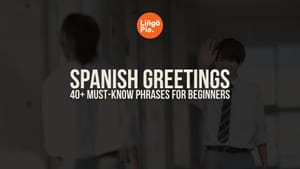Dia de los Muertos is coming up fast, and if your TikTok feed’s been full of marigolds, sugar skulls, and colorful face paint lately, that’s why. Every year around this time, people across Mexico and other Spanish-speaking countries start preparing altars, decorating cemeteries, and celebrating loved ones who’ve passed.
In this post, we’ll explore what makes Día de los Muertos so special. We’ll also explore traditions, food, ofrendas, and parades, and even share some useful Spanish vocabulary related to the celebration.
- 80 Spanish Love Words Every Romantic Should Know
- 8 Scary Movies In Spanish That'll Boost Your Skills
- 100 Easy Spanish Words For Beginners

What is Day of the Dead in Spanish Culture?
In Mexico, Día de los Muertos, or the Day of the Dead, is seen as a joyful reunion between the living and the departed ones. Families believe that for a brief time each year, the spirits of loved ones return to visit. To greet the returning souls, families build ofrendas or altars decorated with marigolds, candles, sugar skulls, and photos. They also visit cemeteries, clean graves, and leave favorite foods and drinks as gifts.
The tradition is believed to go back thousands of years, long before Spanish colonization. The Aztecs and other Indigenous peoples already held festivals honoring the dead, believing death was just another step in life’s cycle. When Catholicism arrived, these ancient customs blended with All Saints’ Day and All Souls’ Day, creating what we now know as Día de los Muertos.
When is Day of the Dead 2025?
Day of the Dead in 2025 will be celebrated from Saturday, November 1 to Sunday, November 2. November 1 is known as Día de los Angelitos (Day of the Little Angels), honoring children who have passed, and November 2 is Día de los Muertos, dedicated to adults.
You’ll also see celebrations start even earlier in some places. For instance, October 27 is now widely recognized as Día de los Muertos de las Mascotas, the Day of the Dead for pets, while October 28 and 30 mark days for honoring those who died tragically or were never found.
Day Of The Dead Traditions
Day Of The Dead Food
During the Day of the Dead, families prepare dishes their loved ones enjoyed most, believing the scent and flavor help guide their spirits home. Recipes vary by region, but all connect generations around the table.
Some of the Day of the Dead food includes:
- Pan de muerto – soft, round bread decorated with bone-shaped dough. Its shape honors the circle of life and death. Families bake it to share with both the living and the spirits.
- Mole – a deep, complex sauce made from chilies, chocolate, and spices. It represents the mixing of cultures and the patience behind family cooking.
- Pozole – a warm stew of hominy and pork. It’s often served during gatherings, symbolizing unity and comfort.
- Tamales – corn dough filled with meat or cheese and wrapped in husks. Preparing them together brings families close in the kitchen.
- Mukbil pollo – a Yucatán dish made of chicken and masa, cooked underground. It’s an older Mayan recipe tied to honoring ancestors.
- Xec – a fresh mix of citrus, radish, and jicama from southern Mexico. Its bright taste reflects the balance between life and death.

Day Of The Dead Ofrendas
An ofrenda (offering) is the altar families build to welcome the spirits of their loved ones during Día de los Muertos. Most ofrendas are arranged on several levels. Two levels represent heaven and earth, while three levels symbolize the sky, earth, and the underworld. Larger altars may have seven steps, each one representing a stage that the soul must pass to reach peace.
Across all versions, the altar must include the four natural elements:
- Earth – represented by food such as pan de muerto and fruit, which feed the visiting souls.
- Wind – shown through papel picado (cut paper), which moves with air currents and represents the presence of spirits.
- Fire – symbolized by candles, which provide light and guide the dead back to the world of the living.
- Water – offered to refresh the souls after their long journey.
Other items complete the altar:
- Copal incense cleanses the area and helps attract spirits.
- Marigolds (cempasúchil) mark a path to the altar with their bright color and strong scent.
- Salt purifies and protects the souls.
- Sugar skulls represent individual lives and the cycle of death.
- Photographs and personal objects identify who the altar is for.
- Monarch butterflies symbolize returning spirits, as they migrate to Mexico each fall.
- Xoloitzcuintle figures represent the dogs that guide souls in the afterlife.
Day Of The Dead Parade
The Day of the Dead parade is the most visible part of the celebration, especially in Mexico City, where thousands of people fill the streets wearing makeup, costumes, and flowers. Some of the most common characters usually seen in the parade include La Catrina, calacas, and alebrijes.
- La Catrina is the most iconic figure—an elegant skeleton woman in a feathered hat and flowing dress. She represents equality in death and has become a national symbol of Día de los Muertos.
- Calacas are full-body skeletons that dance through the crowd, often wearing traditional Mexican clothing or humorous costumes that show death as part of daily life.
- Alebrijes are large handcrafted creatures with wings, horns, and bright patterns. They are made from papier-mâché and carried on floats or worn as massive costumes.
Many participants also carry marigolds, candles, and photos of loved ones, turning the parade into a moving altar.
Day Of The Dead Vocabulary In Spanish
Learning a few key Spanish words connected to Día de los Muertos helps you understand the celebration on a deeper level. Many of these words come from Indigenous languages mixed with Spanish, showing how ancient and modern traditions merged into one.
| Spanish Word | English Meaning |
|---|---|
| Día de los Muertos | Day of the Dead |
| Ofrenda | Altar or offering for the dead |
| Calavera | Skull |
| Calaca | Skeleton figure |
| Pan de muerto | Bread of the dead |
| Cempasúchil | Marigold flower |
| Velas | Candles |
| Copal | Resin incense |
| Papel picado | Decorative cut paper |
| Altar | Shrine to honor the dead |
| Tumba | Grave or tomb |
| Foto del difunto | Photo of the deceased |
| Comida típica | Traditional food |
| Mariposa monarca | Monarch butterfly |
| Catrina | Elegant skeleton figure |
| Esqueleto | Skeleton |
| Flores | Flowers |
| Muerte | Death |
| Espíritu | Spirit |
| Recuerdo | Memory or remembrance |
| Xoloitzcuintle | Sacred Mexican dog that guides souls |
To pick up how they sound and how people actually use them, try learning through real conversations and stories. Watching Spanish TV shows and movies on Lingopie lets you hear this vocabulary used naturally by native speakers while following subtitles and translations. It’s an easy way to build your Spanish skills while exploring one of Mexico’s most meaningful traditions.
Learn Spanish With Lingopie
Día de los Muertos shows how language and culture are tied together. Every word, song, and story keeps memories alive. If you want to connect with Spanish on a real, cultural level, the best way is through immersion.
With Lingopie, you can watch Spanish TV shows, movies, and documentaries with interactive subtitles that let you learn vocabulary as you go. You’ll hear how native speakers talk, pick up phrases naturally, and understand the language in its real setting. Start watching, listening, and learning Spanish the same way people live it—through stories, emotion, and everyday life.
FAQ About The Day Of The Dead
When is the Day of the Dead for pets?
The Day of the Dead for pets, or Día de los Muertos de las Mascotas, is observed on October 27 in Mexico. It’s an informal but growing tradition where families honor the animals that were once part of their homes. People create small altars with their pets’ photos, favorite toys, collars, and treats. The belief is that their spirits also return to visit, just like human loved ones, to share in the warmth and love of the celebration.
Who is La Catrina and why is she important?
La Catrina is the elegant female skeleton created by Mexican artist José Guadalupe Posada in the early 1900s. She was meant to mock social classes and remind people that death comes for everyone. Over time, she became the central figure of Día de los Muertos and a national symbol of equality in death.
What is the purpose of the Day of the Dead?
The celebration is meant to honor and remember loved ones who have passed away. Instead of focusing on grief, families celebrate their lives through food, music, and shared memories. It’s about keeping connections alive between generations and showing that death is a continuation, not an end.
What are the main symbolisms of the Day of the Dead?
The three core symbols are marigolds, copal incense, and sugar skulls. Marigolds guide the spirits home with their bright color and scent. Copal incense purifies the air and helps the souls find their way. Sugar skulls represent the cycle of life and death, reminding everyone that both belong together.


![Spanish Day Of The Dead: Traditions & Vocab Guide [2025]](/blog/content/images/size/w1200/2025/10/spanish-day-of-the-dead-2.jpg)


![How To Speak Korean: Classes, Apps, And Immersion Tips [2025]](/blog/content/images/2025/10/how-to-speak-korean-2.jpg)
![Korean Aegyo: Korean Words And Gestures To Look And Sound Cute [2025]](/blog/content/images/size/w1200/2025/10/Korean-agyeo.png)

![How to Learn Spanish as An Adult [Guide]](/blog/content/images/size/w300/2025/12/How-to-Learn-Spanish-as-An-Adult.jpg)
![How To Do The Mexican Accent [Complete Guide]](/blog/content/images/size/w300/2024/06/Understanding-Mexican-Spanish-Accents.jpg)
